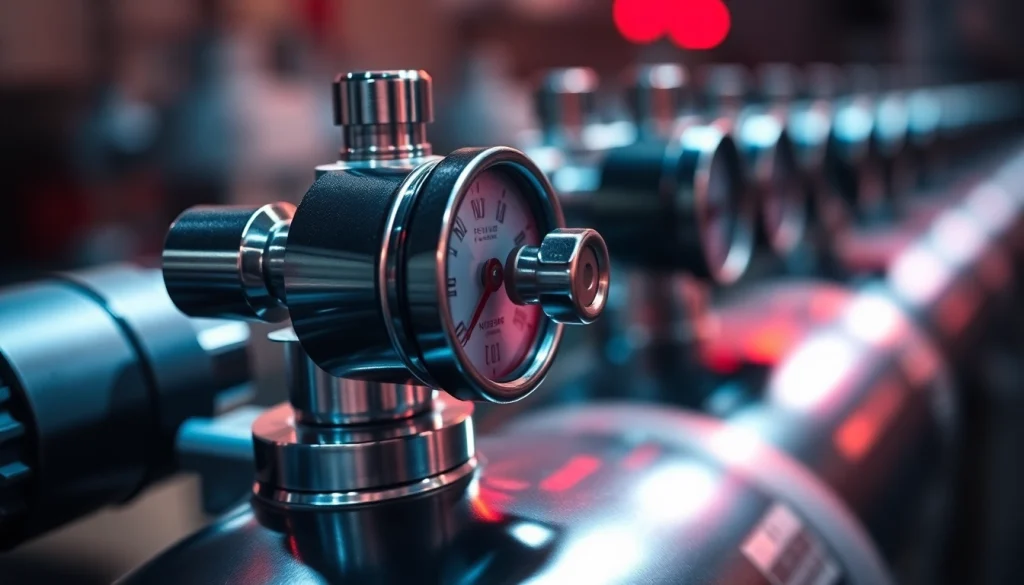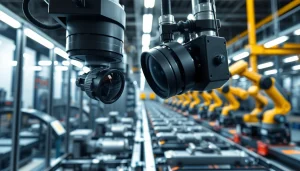Essential Nitrogen Regulators: What You Need to Know for Optimal Performance

Understanding Nitrogen Regulators
1. What is a Nitrogen Regulator?
A nitrogen regulator is a specialized device that controls the pressure and flow of nitrogen gas from a pressurized cylinder or tank to the applications that require it. Nitrogen, an inert gas, is widely used in various industries for purposes such as purging, pressurization, and refrigeration. By using a nitrogen regulator, users can ensure a consistent and safe supply of gas at the desired pressure level. Understanding the functionalities and importance of nitrogen regulators is critical for various applications, including HVAC systems, food processing, and medical applications.
2. How Do Nitrogen Regulators Work?
Nitrogen regulators work by reducing the high pressure of nitrogen gas stored in cylinders to a lower, usable pressure. The primary design of a nitrogen regulator involves a diaphragm mechanism that responds to pressure changes and adjusts the flow accordingly. The regulator is typically equipped with two pressure gauges: one shows the incoming cylinder pressure, while the other indicates the outgoing pressure. This allows users to monitor the pressure levels accurately and make adjustments as needed.
3. Common Applications of Nitrogen Regulators
Nitrogen regulators find applications in various fields, including:
- HVAC and Refrigeration: Used for pressure testing and refrigerant charging in air conditioning systems.
- Food and Beverage: Employed in beer dispensing systems to maintain carbonation levels and quality.
- Industrial Processes: Facilitates purging of tanks and lines to remove contaminants and maintain product integrity.
- Medical Usage: Used in surgical tools and other medical devices requiring precise pressure control.
Types of Nitrogen Regulators
1. Single Stage vs. Dual Stage Nitrogen Regulators
Nitrogen regulators can be categorized into single-stage and dual-stage types. Single-stage regulators are designed to reduce the pressure from the cylinder to the outlet pressure in one step. They are suitable for applications where the cylinder pressure remains relatively constant. On the other hand, dual-stage regulators provide more control over outlet pressure, as they reduce pressure in two stages, ensuring that the outlet pressure remains stable even as cylinder pressure decreases. These are ideal for applications that require precise pressure control over extended periods.
2. Adjustable vs. Preset Nitrogen Regulators
Adjustable nitrogen regulators allow users to set the output pressure according to their specific requirements. This versatility is beneficial for applications requiring different pressure settings over time. Conversely, preset nitrogen regulators come with fixed output pressures, which are ideal for applications that maintain a consistent requirement, enhancing convenience and safety.
3. Specialty Nitrogen Regulators for Specific Needs
Specialty nitrogen regulators are tailored for specific industrial needs. For example, some regulators are designed for high-pressure applications, while others are built for low-flow scenarios. There are also regulators equipped with safety features such as pressure relief valves to prevent over-pressurization, which can lead to equipment damage or safety hazards.
Selecting the Right Nitrogen Regulator
1. Key Features to Consider
When selecting a nitrogen regulator, consider key features such as pressure range, flow capacity, gauge quality, and material construction. The pressure range should match the requirements of your application, while flow capacity dictates how quickly nitrogen can be dispensed. Furthermore, durable materials are essential for ensuring longevity.
2. How Pressure Ratings Impact Performance
Pressure ratings directly affect the efficacy of a nitrogen regulator. It is crucial to choose a regulator with a suitable inlet and outlet pressure rating for your specific application to ensure that it operates within the safe limits. Failure to do so could lead to malfunction or safety hazards, particularly in high-pressure environments.
3. Comparing Brands and Models
With numerous brands and models available in the market, conducting a thorough comparison based on features, reliability, and reviews is essential. Well-known manufacturers often provide warranties and customer support, making their products a safer choice. Reading user reviews and expert opinions can also provide insight into performance and durability.
Installing and Maintaining Your Nitrogen Regulator
1. Installation Steps for Optimal Safety
Proper installation of nitrogen regulators is critical for safety and optimal performance. Here’s a step-by-step guide:
- Identify the proper connection type (CGA fitting) and ensure compatibility with the nitrogen cylinder.
- Secure the regulator to the cylinder tightly, ensuring that no gas leaks can occur.
- Connect the outlet hose to the application requiring nitrogen, ensuring that the fittings are secure.
- Open the cylinder valve slowly, monitoring for any leaks before proceeding with use.
By following these steps, users can mitigate accidents and ensure effective nitrogen delivery.
2. Routine Maintenance Tips
Regular maintenance helps prolong the life of your nitrogen regulator. Here are some maintenance tips:
- Check for leaks at connections and fittings regularly, using a leak detection solution.
- Inspect gauges for accuracy and functionality, replacing them if they show signs of damage.
- Clean the regulator periodically to remove dirt and debris that might affect performance.
- Store regulators in a dry environment to prevent corrosion of internal components.
3. Troubleshooting Common Issues
Common problems with nitrogen regulators can include inconsistent pressure output, leaks, and gauge malfunctions. Here are troubleshooting tips:
- If you experience fluctuating pressure, check the inlet pressure from the cylinder and ensure that it is stable.
- For leaks, tighten fittings and connections, replacing worn-out seals or O-rings as necessary.
- In the case of gauge failures, consider replacing gauges with high-quality alternatives to maintain measurement accuracy.
Conclusion and Future Trends in Nitrogen Regulation
1. Innovations in Nitrogen Regulators
The future of nitrogen regulation is evolving with technological advancements. Innovations such as smart regulators that integrate digital pressure readings and analytics are on the rise. These smart devices offer enhanced control and monitoring capabilities, contributing to more efficient nitrogen management.
2. Environmental Considerations and Industry Standards
As industries move towards more sustainable practices, advancements in nitrogen regulation technology aim to minimize waste and enhance efficiency. This includes compliance with environmental standards and regulations that promote safe use while minimizing environmental impact.
3. Future Applications of Nitrogen Technology
The ongoing exploration of nitrogen technology is expanding its applications beyond traditional areas. Fields such as renewable energy storage and advanced food preservation methods leverage nitrogen in innovative ways. As technology progresses, nitrogen regulators will likely adapt to meet these new applications comfortably.
Investing in a high-quality nitrogen regulator is essential for ensuring the efficiency and safety of applications where nitrogen is needed. With careful selection, proper installation, and routine maintenance, users can ensure optimal performance and longevity of their nitrogen supply systems.







